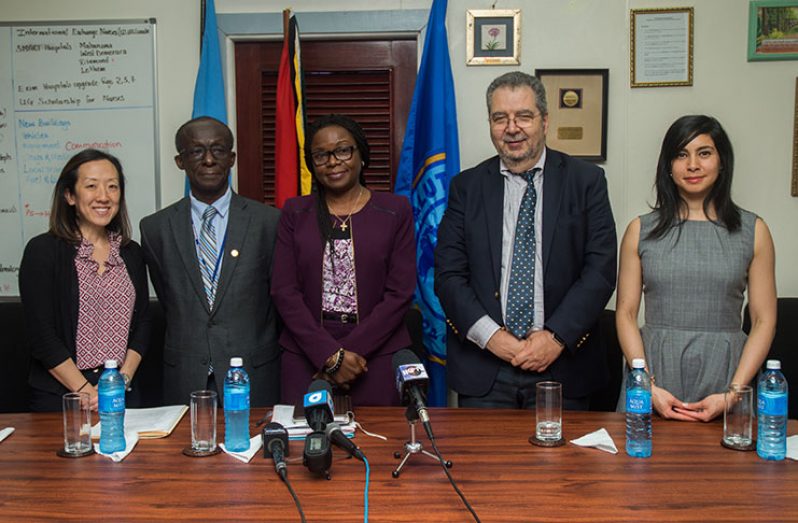THE triple therapy IDA (Ivermectin, Diethycarbamazine and Albendazole) will accelerate the elimination of Lymphatic Filariasis, a disabling and disfiguring neglected tropical disease, commonly called Filaria or ‘Big Foot’.
According to the World Health Organisation (WHO), “Evidence from recent research studies has demonstrated that adding Ivermectin to the currently recommended combination of Diethylcarbamazine citrate plus Albendazole clears microfilaria more efficiently from the blood than the two-drug regimen, and is equally safe.”
At a recent press conference, a high-level Technical Cooperation Mission joined the Ministry of Public Health and the local Pan American Health Organisation (PAHO) office in advocating for Guyanese to embrace the use of the triple-therapy IDA when the 2019 Mass Drug Administration is rolled out in October.
Guyana’s Deputy Chief Medical Officer (DCMO), Dr. Karen Campbell; PAHO/WHO Representative, Dr. William Adu-Krow; PAHO Regional Adviser on Neglected Infectious Diseases, Dr. Santiago Nicholls; Centers for Disease Control and Prevention (CDC) Representative, Dr. Kim Won; and Dr. Natalia Machuca from USAID have all underscored the importance of Guyana utilising the triple-drug therapy, IDA, as against the two-drug regimen – Diethycarbamazine and Albendazole (DA) at this stage.
Dr. Campbell explained that the use of the triple therapy IDA from this year is necessary if Guyana is to be successful in interrupting the transmission of Lymphatic Filariasis by 2020 as required.
“The challenge is, for Guyana to reach eligibility for the elimination status for 2020, we would need another three years of Mass Drug Administration (MDA), using the two-drug regimen that we have been using in the past, (but) we don’t have three years. So, if we are to reach eligibility, we have to slightly adjust our strategy. The strategy that we have available to us is to implement a triple-drug therapy (IDA),” the Deputy Chief Medical Officer explained.
Guyana, she further explain, would have to achieve over 80 per cent coverage for the next two years, using the triple-drug therapy (IDA), in order to become eligible for elimination status.
In this part of the world, Costa Rica, Trinidad and Suriname have achieved elimination status, while Guyana, Haiti, The Dominican Republic and Brazil remain endemic to Lymphatic Filariasis.
Questioned about the side effects of using the triple-drug therapy, which is new to Guyana, Dr. Campbell said the effects are mild, as the drug regimen is in use in other parts of the world. The side effects,she said, include headache, nausea and fever in some cases, and are nothing compared to the pain and suffering Filaria causes when left untreated.
Dr. Adu-Krow made it clear that all medication have side effects. He, however, noted that in the case of the triple-drug therapy, the side effects are similar to those of the two-drug regimen.
Weighing in on the issue, Dr. Nicholls said that based on a study completed in late November 2017, the triple-drug therapy destroys the microfilaria present in the blood of the infected at a faster rate when compared to the two-drug regimen; saves time and money, and has minor side effects. “When IDA was compared to DA, the rate of reduction of microfilaria, the parasite in the blood, was much faster than it was with DA. So the studies concluded that it was enough to give two years of IDA instead of five years of DA. It reduces the time by three years, but it also has implications for budget and logistics,” Dr. Nicholls noted.
He said that conducting a Mass Drug Administration for a period of five years with a required coverage of 65 per cent is no easy task. Notably, at this stage, Guyana, according to the health authorities, cannot meet the 2020 mark if it continues with the two-drug regimen.
In 2000, Guyana embraced WHO’s Global Programme for the Elimination of Lymphatic Filariasis by 2020, which entails a comprehensive strategy to stop the spread of the infection through large-scale annual Mass Drug Administration and alleviating the suffering caused by the disease.
In 2001, a mapping among schoolchildren revealed that Guyana is endemic to Lymphatic Filariasis. The MDA was identified as the best intervention to eliminate the disease.
“In 2003, Guyana started with the use of Diethyl Carbamazine (DEC) fortified salt; however, it proved difficult to confirm the epidemiological coverage. In 2008, Guyana started to implement, in some geographical settings, Mass Drug Administration using diethylcarbamazine and albendazole pills,” Dr. Campbell had explained.
Since then, the Public Health Ministry has had difficulties in successfully executing five consecutive of the MDA as required for the elimination of the disease.
Guyana’s current strategy is tailored to target the population within schools and workplaces, with support coverage at fixed points such as market places and religious institutions, the DCMO said.
With Guyana’s geographical coverage currently at 44 per cent, Dr. Campbell said key to scaling it up to 100 per cent is a remapping survey which is being conducted in the six regions: One (Barima-Waini), Two (Pomeroon-Supenaam), Six (East Berbice-Corentyne), Seven (Cuyuni-Mazaruni), Eight (Potaro-Siparuni), and Nine (Upper Takutu-Upper Essequibo) that have not yet implemented the Mass Drug Administration. In the past, MDA was only conducted in Regions Three (Essequibo Islands-West Demerara), Four (Demerara-Mahaica), Five (Mahaica-Berbice), and Ten (Upper Demerara-Berbice). “This survey will give an updated picture as to which other implementation units need to be included in the current Mass Drug Administration excise,” the DCMO explained.
PAHO/WHO donated the Diethycarbamazine and Albendazole for the initial rounds of the MDA, and has committed to supply the country with additional drugs for the IDA if it is accepted on the ground.



.jpg)











